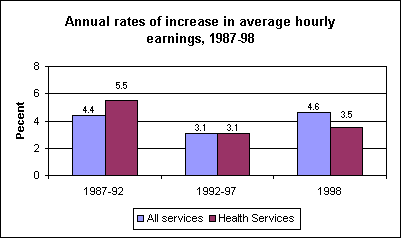An official website of the United States government
 United States Department of Labor
United States Department of Labor
In 1998, hourly earnings in the health services industry rose 3.5 percent, fully 2 percentage points under its 1987-92 pace. Earnings growth in the health service industry was 1.1-percentage points higher than in the services industry division in the 1987-92 period. Growth fell to the same rate as the service industry in 1992-97, and was 1.1-percentage points below the service industry average in 1998.

[Chart data—TXT]
Although wage growth has subsided in health services, average hourly earnings in the industry still were 88 cents greater than the average for all services industry workers. In 1998, workers in health services earned $13.72 per hour compared to an average of $12.84 for the broader services industry division.
While earnings growth in the health services industry was edging down, business services saw earnings increase sharply. Earnings in business services grew by 2.7 percent per year from 1987-92, 3.5 percent in 1992-97, and 6.1 percent in 1998.
Industry employment and earnings data are a product of the Current Employment Statistics program. For more information, see "Health services industry: still a job machine?"Monthly Labor Review, March 1999.
Bureau of Labor Statistics, U.S. Department of Labor, The Economics Daily, Slower growth in health services earnings in the 90s at https://www.bls.gov/opub/ted/1999/may/wk3/art01.htm (visited April 19, 2024).

